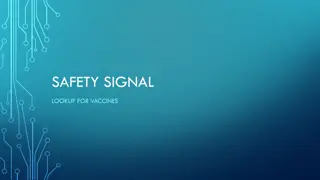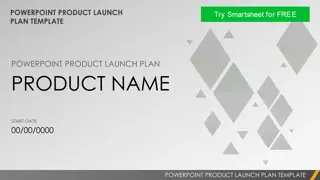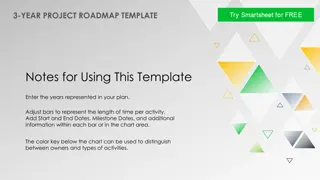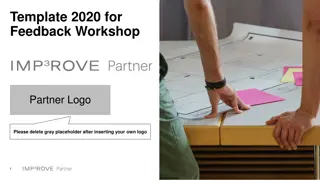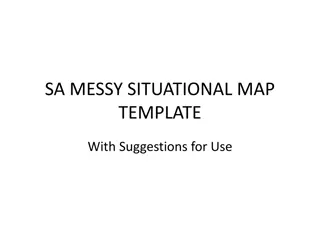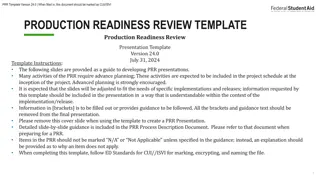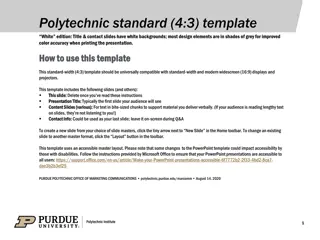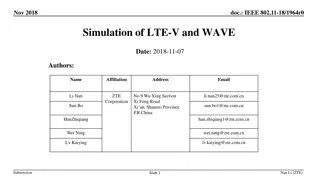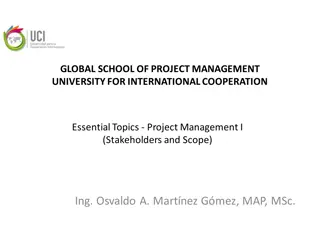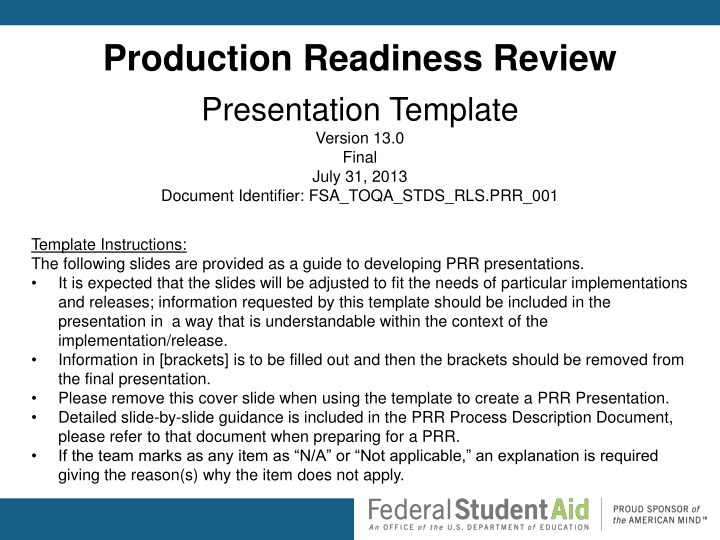
Production Readiness Review Presentation: System Background & Release Scope
"Get insights into the business background of the system and the scope of its upcoming release. Explore key details such as legislative requirements, technology used, user support, and more. Dive into the benefits and impact of the release with detailed agenda points." (250/500)
Download Presentation

Please find below an Image/Link to download the presentation.
The content on the website is provided AS IS for your information and personal use only. It may not be sold, licensed, or shared on other websites without obtaining consent from the author. If you encounter any issues during the download, it is possible that the publisher has removed the file from their server.
You are allowed to download the files provided on this website for personal or commercial use, subject to the condition that they are used lawfully. All files are the property of their respective owners.
The content on the website is provided AS IS for your information and personal use only. It may not be sold, licensed, or shared on other websites without obtaining consent from the author.
E N D
Presentation Transcript
Production Readiness Review Presentation Template Version 13.0 Final July 31, 2013 Document Identifier: FSA_TOQA_STDS_RLS.PRR_001 Template Instructions: The following slides are provided as a guide to developing PRR presentations. It is expected that the slides will be adjusted to fit the needs of particular implementations and releases; information requested by this template should be included in the presentation in a way that is understandable within the context of the implementation/release. Information in [brackets] is to be filled out and then the brackets should be removed from the final presentation. Please remove this cover slide when using the template to create a PRR Presentation. Detailed slide-by-slide guidance is included in the PRR Process Description Document, please refer to that document when preparing for a PRR. If the team marks as any item as N/A or Not applicable, an explanation is required giving the reason(s) why the item does not apply.
[System Name and Release Number] Production Readiness Review [Date] [Document Identifier Technology Office PRRs, please contact CM Team for a Document Identifier. All others, please delete the document identifier item.]
Agenda Business Background of System Scope of this release Schedule Overview Review of Open Risks Infrastructure Diagram Testing Activities and Results Configuration Management Data Center Readiness Security & Privacy 10. Operations and Maintenance Planning 11. Documentation needed for Implementation and Operations 12. End User Support and Communication 13. Lessons Learned 14. Meeting Closure and Sign-off 1. 2. 3. 4. 5. 6. 7. 8. 9. 3
[System] Business Background [Describe the business purpose of the system in general. Describe legislative requirements that the system supports. Describe major FSA functions that are performed by the system. Describe technology used by the system at a high level. This includes development tools, software languages, database system used, and major components that are being leveraged. Example: ABC was developed in Drupal and uses MySQL Enterprise database. ABC utilizes the General Service Administration USASearch engine. Describe number and type of users supported by the system] 4
Scope of Release [Insert Release #] [Describe the scope of the release that is being implemented. Describe the business benefits that will be realized by implementing this release. Describe the technology changes being implemented by this release. Examples: new functionality to meet a legislative requirement, improvements to the user experience, moves the system to a more current version of a product, expands capacity, etc.] 5
Scope of Release [Insert Release #] [Describe the business impact of delaying implementation. Include the maximum implementation delay that could be tolerated and still meet FSA s business objectives. If there is a legislative or regulatory deadline associated with this implementation, please include that information.] 6
Schedule Overview Planned (baseline) Completion Actual Completion Requirements 1/30/2008 2/30/2008 Requirements Review (LMM Technical Stage Gate 3) 2/3/2008 3/3/2008 Design 2/30/2008 4/20/2008 Design Review (LMM Technical Stage Gates 1A and 1B) 3/5/2008 5/5/2008 Development 5/30/2008 7/30/2008 Test Readiness Review for System Test (LMM Technical Stage Gate 2) 6/1/2008 6/5/2008 8/1/2008 8/5/2008 System Testing 6/15/2008 8/15/2008 Intersystem Testing 6/30/2008 8/30/2008 508 Compliance Testing 6/30/2008 8/15/2008 Performance Testing 8/10/2008 10/10/2008 Test Readiness Review for User Acceptance Testing (LMM Technical Stage Gate 2) 7/5/2008 7/10/2008 8/20/2008 8/30/2008 User Acceptance Testing 7/30/2008 9/30/2008 Code Freeze (start and end) 8/1/2008 8/14/2008 10/1/2008 - 10/31/2008 Security Vulnerability Scanning (final completion date for all non-prod scan activities) 8/14/2008 10/14/2008 Service Delivery Review (SDR) 8/15/2008 10/15/2008 PRR (LMM Technical Stage Gate 4) 8/30/2008 10/30/2008 Production Cutover 9/1/2008 11/1/2008 7
Review of Open Risks Risk Category Risk Description Probability Impact Mitigation Strategy Risk Owner [Infrastructure] [High] [High] [Application Interfaces] [Moderate] [Moderate] [Operations] [Low] [Low] [Note: This slide should include only the risks related to deploying this release or implementing this specific infrastructure change to production, not the entire project risk register. If no risks are identified, please list No risks identified. Do not list NA Typical Risk Categories include: Business, System Function, Testing, Infrastructure, Application Interfaces, Operations, Release Timing, Vulnerability Scan Finding, Security Control Risk, Other add categories as needed] Probability Impact Scale Definition Scale Definition Risk has a 50% or greater chance of occurring. Risk is more likely to occur than not. Risk has a greater than 10% and less than 50% chance of occurring Risk has a 10% or less chance of occurring If realized, the risk results in an inability to meet business mission/outcomes of the system. If realized, the risk results in a degraded ability to meet business mission/outcomes of the system. If realized, the risk results in annoyance or inconvenience, but the business mission/outcomes of the system will continue to be met. High High Moderate Moderate Low Low 8
Infrastructure Diagram [Insert an infrastructure diagram for the system. For implementations that modify the system infrastructure, please insert two diagrams one showing the existing infrastructure and one showing the new infrastructure to be implemented. This slide is optional/not required for PRRs that only cover application releases. It is required for PRRs that are primarily focused on infrastructure changes.] 9
Testing Activities Test Phase Organization Status of Testing Executing Tests System Testing System Testing evaluates the integrated system (application) as a whole. The Testing Team performs tests to ensure that each function of the system works as expected and that any errors are documented, analyzed, and resolved appropriately. [Not Performed / In Progress / Complete For responses of Not Performed or In Progress, please provide explanation.] [Company Name of Contractor / Federal Student Aid Team] Intersystem Testing Testing of the interfaces between systems. [Not Performed / In Progress / Complete For responses of Not Performed or In Progress, please provide explanation.] [Company Name of Contractor / Federal Student Aid Team] Accessibility (508) Testing Testing to ensure that employees and members of the public with disabilities have access to and use of information that is comparable to that available to individuals without disabilities. [Not Performed / In Progress / Complete For responses of Not Performed or In Progress, please provide explanation.] ED OCIO Assistive Technology Team [Only the ED OCIO Assistive Technology Team can determine that 508 testing is not needed for a release. If this determination is made, please include an e-mail from that team confirming the decision.] Performance testing Test the performance characteristics of the system, including user load and throughput for the user interface, transaction/batch processing, and database. [Not Performed / In Progress / Complete For responses of Not Performed or In Progress, please provide explanation.] FSA Enterprise Performance Test (EPT) Team User Acceptance Testing Formal testing with respect to Application Owner needs, requirements, and processes conducted to determine whether a system satisfies the acceptance criteria and to enable the user, customers, or other authorized entity to determine whether to accept the system. [Not Performed / In Progress / Complete For responses of Not Performed or In Progress, please provide explanation.] Federal Student Aid [FSA Office Name] 10
Test Results Summary # Test Cases/ Scripts DEFECTS OPENED DEFECTS CLOSED DEFECTS DEFERRED DEFECTS RESULTING IN ENHANCEMENTS Type of Testing Urgent High Med Low Total Urgent High Med Low Total Urgent High Med Low Total Urgent High Med Low Total System 50 4 4 4 4 16 1 1 1 1 4 1 1 1 1 4 2 2 2 2 8 Intersystem 30 4 4 4 4 16 1 1 1 1 4 1 1 1 1 4 2 2 2 2 8 Accessibility 20 4 4 4 4 16 1 1 1 1 4 1 1 1 1 4 2 2 2 2 8 Performance User Acceptance 10 4 4 4 4 16 1 1 1 1 4 1 1 1 1 4 2 2 2 2 8 100 4 4 4 4 16 1 1 1 1 4 1 1 1 1 4 2 2 2 2 8 TOTALS 210 20 20 20 20 80 5 5 5 5 20 5 5 5 5 20 10 10 10 10 40 Defect Severity Levels Urgent Prevents the accomplishment of an operational or mission essential capability High Adversely affects the accomplishment of an operational or mission essential capability and no work around solution is known. Medium Adversely affects the accomplishment of an operational or mission essential capability, but a work around solution is known and productivity is negatively impacted. Low Results in user inconvenience or annoyance but does not affect a required operational or mission essential capability. 11
System Test Results Open Defects: [note: FSA generally does not implement releases with open urgent or high defects] Medium: [provide description of the defect and the business functionality impacted by the defect] Low: [provide description of the defect and the business functionality impacted by the defect] Closed Defects: [note: only provide urgent and high for closed defects] Urgent: [provide description of the defect and the business functionality impacted by the defect] High: [provide description of the defect and the business functionality impacted by the defect] 12
Intersystem Test Results Open Defects: [note: FSA generally does not implement releases with open urgent or high defects] Medium: [provide description of the defect and the business functionality impacted by the defect] Low: [provide description of the defect and the business functionality impacted by the defect] Closed Defects: [note: only provide urgent and high for closed defects] Urgent: [provide description of the defect and the business functionality impacted by the defect] High: [provide description of the defect and the business functionality impacted by the defect] 13
Accessibility Test Results Open Defects: [note: FSA generally does not implement releases with open urgent or high defects] Medium: [provide description of the defect and the business functionality impacted by the defect] Low: [provide description of the defect and the business functionality impacted by the defect] Closed Defects: [note: only provide urgent and high for closed defects] Urgent: [provide description of the defect and the business functionality impacted by the defect] High: [provide description of the defect and the business functionality impacted by the defect] 14
Performance Test Results [Please contact the Enterprise Performance Test Team (EPT). When performance testing is conducted, EPT will provide slides to insert for performance test results. This slide and the following slide should be replaced with the slides provided by the EPT Team. The following slide is provided as a format for teams that conduct performance testing internally, rather than through EPT.] 15
Performance Test Results Type of Test Description of Test Performed Performance Targets Performance Results Peak Stress Perf. Over Time Failover 16
User Acceptance Test Results Open Defects: [note: FSA generally does not implement releases with open urgent or high defects] Medium: [provide description of the defect and the business functionality impacted by the defect] Low: [provide description of the defect and the business functionality impacted by the defect] Closed Defects: [note: only provide urgent and high for closed defects] Urgent: [provide description of the defect and the business functionality impacted by the defect] High: [provide description of the defect and the business functionality impacted by the defect] 17
Configuration Management The build number of this release is: [obtain number from system s configuration manager] Functional Configuration Audit (FCA): [Describe the results of the FCA, if no formal FCA was performed, please indicate FCA was not performed for this release. ] Physical Configuration Audit (PCA): [Describe the results of the PCA, if no formal PCA was performed, please indicate PCA was not performed for this release. ] 18
EBC/SharePoint Coordination This release is being implemented in the [Employee Enterprise Business Collaboration (EEBC) or Partner Enterprise Business Collaboration (PEBC)] Production Environment. This release is a [sandboxed or farm] solution. The EBC component(s) used by this release include [MS SharePoint, Serena, K2, etc.] [Provide a high-level description of any custom development done as part of this release. For example: This release uses out-of-the-box MS SharePoint features for most functions; however, two pages were customized with Java code to support specific business requirements related to advanced search features in the database.] This release was approved by the EBC Change Control Board on [date]. [Name] is the EBC Change Control Board Representative for this application. [Note: This slide only applies to releases in the EEBC and PEBC SharePoint environments. If the release covered by the PRR is not being implemented in EEBC or PEBC, then please remove this slide.] 19
Data Center Readiness This release will be implemented in FSA s Virtual Data Center in Plano, TX. [identify other data center if applicable] Operational roles and responsibilities between different teams (data center, middleware, application support) have been defined and communicated. CMDB review and validation completed on [date usually done in conjunction with SDR, if release does not have an SDR this validation still needs to be done]. Application Specific Information (ASI) Document, including infrastructure diagram, was last updated on [date]. Disaster recovery objectives revalidated based on this release: Recovery Time Objective (RTO): [Mission Essential = 48 hours or Essential = 72 hours or Non-Essential = 72 hours] Recovery Point Objective (RPO): [Mission Essential = 24 hours or Essential = 24 hours or Non-Essential = 48 hours] 20
Data Center Readiness Change Request (CCM Ticket) for production implementation has been submitted to the data center. Ticket # [insert ticket number]. The release will be implemented [during / outside of] the normal maintenance window [state outage period if outside of maintenance window]. Hour-by-Hour Plan has been completed and all resources understand the actions required to complete implementation. Roll-back Plan can be completed within the maintenance window [if extension would be required, indicate how long] 21
Data Center Readiness A roll-back of this release will occur if [insert specific criteria for when a roll-back would occur] [describe the Roll-back Plan - would the previous code base be installed, would a backup be restored, etc.] The decision to execute the roll-back plan will be made by the technical team implementing the release based on the criteria described in this PRR, with approval from the System Owner and VDC Manager. 22
Security and Privacy Documented system owner is [name] ISSO is [name], confirmed by assignment memo dated [date] Alternate ISSO is [name], confirmed by assignment memo dated [date] System is classified as a [GSS, Major Application, Minor Application, or a component of one of these categories] System [does/does not] contain Personally Identifiable Information (PII). [Provide a summary of the types of data elements for the system] Confidentiality is categorized as [High, Moderate, Low] Integrity is categorized as [High, Moderate, Low] Availability is categorized as [High, Moderate, Low] 23
Security and Privacy The System Owner and ISSO [have / have not] reviewed the documents on the PRR slides titled Documentation needed for Implementation and Operations and verify that all appropriate updates have occurred. The ISSO has reviewed the website(s) for the system and validated that a Human and Machine Readable Privacy Policy [is / is not] in place. [if not in place, please explain] The System Owner and ISSO have evaluated the changes being implemented in this release and have determined that there [is / is not] an impact to the security posture/controls of the system [state the impact if there is one]. The ISSO has verified this release [does/does not] involve the collection of any new data elements or data collection from new data subjects, and that this release [does/does not] involve the sharing of data with new business partners. The ISSO has validated that a current Authority to Operate (ATO) is in place for [system name]. The ATO was signed on [date]. The Monthly Authenticated Vulnerability Scans are scheduled for the system on [date; i.e. 5th calendar day of month, second Saturday of month, etc.]. 24
Security Vulnerability Scans Security Scan Coordination for this release Scans occurring before PRR Scan Tool(s) Scan Request Submission Date Scan Cyber Sec. Analysis Complete Date OVMS Entry Date Completed Date Application Scan of Non-Production Environments (Dev, Test, Stage, etc.) Database Scan of Non-Production Environments (Dev, Test, Stage, etc.) OS/Infrastructure Scan of Non- Production Environments (Dev, Test, Stage, etc.) Scans occurring after PRR Scan Tool(s) Scan Request Submission Date Date Scans are Scheduled to run Application Scan of Production Database Scan of Production Operating System / Infrastructure Scan of Production 25
Security Vulnerability Scans Application Scan threat levels identified by Cyber Security / Scan Tools Critical High Moderate Scan Results addressed by Corrective Action Plan (CAP) Pending Resolution Scan Results addressed by approved Accepted Risk (AR) Scan Results addressed by existing documented False Positive (FP) New scan findings entered in OVMS from this scan (New CAP, New AR, or New FP)* Total *Details of new scan findings entered in OVMS are addressed on the next slide. 26
Security Vulnerability Scans Resolution of new Application Scan Findings by ISSO OVMS ID Threat Level (Identified by Cyber Security / Scan Tools Critical, High, Moderate) Compensating Control(s) Residual Risk Level (Identified in OVMS - High, Moderate, Low)** Description of Finding Responsible ISSO (Name) Mitigation Strategy (CAP, AR, or FP) ** Residual Risk Level in OVMS may be the same or lower than the initial threat level identified by Cyber Security / Scan Tools (on previous slide) due to compensating controls being in place. 27
Security Vulnerability Scans Database Scan threat levels identified by Cyber Security / Scan Tools Critical High Moderate Scan Results addressed by Corrective Action Plan (CAP) Pending Resolution Scan Results addressed by approved Accepted Risk (AR) Scan Results addressed by existing documented False Positive (FP) New scan findings entered in OVMS from this scan (New CAP, New AR, or New FP)* Total *Details of new scan findings entered in OVMS are addressed on the next slide. 28
Security Vulnerability Scans Resolution of new Database Scan Findings by ISSO OVMS ID Threat Level (Identified by Cyber Security / Scan Tools Critical, High, Moderate) Compensating Control(s) Residual Risk Level (Identified in OVMS - High, Moderate, Low)** Description of Finding Responsible ISSO (Name) Mitigation Strategy (CAP, AR, or FP) ** Residual Risk Level in OVMS may be the same or lower than the initial threat level identified by Cyber Security / Scan Tools (on previous slide) due to compensating controls being in place. 29
Security Vulnerability Scans Operating System and Infrastructure Scan threat levels identified by Cyber Security / Scan Tools Critical High Moderate Scan Results addressed by Corrective Action Plan (CAP) Pending Resolution Scan Results addressed by approved Accepted Risk (AR) Scan Results addressed by existing documented False Positive (FP) New scan findings entered in OVMS from this scan (New CAP, New AR, or New FP)* Total *Details of new scan findings entered in OVMS are addressed on the next slide. 30
Security Vulnerability Scans Resolution of new Operating System and Infrastructure Scan Findings by ISSO OVMS ID Threat Level (Identified by Cyber Security / Scan Tools Critical, High, Moderate) Compensating Control(s) Residual Risk Level (Identified in OVMS - High, Moderate, Low)** Description of Finding Responsible ISSO (Name) Mitigation Strategy (CAP, AR, or FP) ** Residual Risk Level in OVMS may be the same or lower than the initial threat level identified by Cyber Security / Scan Tools (on previous slide) due to compensating controls being in place. 31
Operations and Maintenance Operations and Maintenance support for [System Name] is provided by [Contractor Name, FSA TO Application Support Team, etc.] The contract covering O&M support for this system is [contract name and number] [System Name] requires [number] of full time equivalents (FTEs) to support the system. [Note: Required for FSA In-House Development, may be omitted for already-contracted O&M activities] The System Owner has reviewed the backup schedule that is on file with the infrastructure provider (data center) and validated that appropriate backups are scheduled to occur. The System Owner validates that Capacity Planning activities have occurred or are scheduled for the system. 32
Documentation needed for Implementation and Operations Ent. WBS Code Document Status Document Version Number of Final Accepted Document Date of Final Accepted Document Comments - Created Document - Updated Existing Doc. - Part of Another Doc. - No update needed - Not applicable to this release (If included in another document, indicate the name of that document) [fill in document status from choices above] [version #] [date] [comments] 1.1.1 Investment Request [document status] [version #] [date] [comments] 1.1.2 Business Case/Exhibit 300 [document status] [version #] [date] [comments] 1.1.3 Project Charter Lifecycle Management Methodology (LMM) Work Breakdown Structure Dictionary and Tailoring Plan Information System Security Officer (ISSO) Appointment Letter [document status] [version #] [date] [comments] 1.2.1 [document status] [version #] [date] [comments] 3.1 [document status] [version #] [date] [comments] 3.2.1 Privacy Threshold Analysis [document status] [version #] [date] [comments] 3.2.2 Privacy Impact Assessment [document status] [version #] [date] [comments] 3.2.3 System of Records Notice (SORN) [document status] [version #] [date] [comments] 3.3.1 Memorandum of Understanding [document status] [version #] [date] [comments] 3.3.2 Computer Matching Agreement [document status] [version #] [date] [comments] Interconnection Security Agreement (ISA) 3.3.3 33
Documentation needed for Implementation and Operations Ent. WBS Code Document Status Document Version Number of Final Accepted Document Date of Final Accepted Document Comments - Created Document - Updated Existing Doc. - Part of Another Doc. - No update needed - Not applicable to this release (If included in another document, indicate the name of that document) [fill in document status from choices above] [version #] [date] [comments] 3.4.1 Business Impact Analysis (BIA) Information Technology (IT) Contingency Plan (Includes Test Plan) [document status] [version #] [date] [comments] 3.4.2 [document status] [version #] [date] [comments] 3.5.1 Data Sensitivity Worksheet [document status] [version #] [date] [comments] 3.5.2 System Authorization Boundary [document status] [version #] [date] [comments] 3.5.3 System Security Plan Authority To Operate Letter and Briefing [document status] [version #] [date] [comments] 3.7 [document status] [version #] [date] [comments] 3.9 Data Retention Schedule [document status] [version #] [date] [comments] 4.2 Requirements Management Plan [document status] [version #] [date] [comments] 4.5 Detailed Requirements Document [document status] [version #] [date] [comments] 4.6 Requirements Traceability Matrix 34
Documentation needed for Implementation and Operations Ent. WBS Code Document Status Document Version Number of Final Accepted Document Date of Final Accepted Document Comments - Created Document - Updated Existing Doc. - Part of Another Doc. - No update needed - Not applicable to this release (If included in another document, indicate the name of that document) [fill in document status from choices above] [version #] [date] [comments] 4.7 Data Migration Plan [document status] [version #] [date] [comments] 5.1 Configuration Management Plan [document status] [version #] [date] [comments] 5.3 Detailed Design Document Solution Source Code and Deployable Packages [document status] [version #] [date] [comments] 5.4 [document status] [version #] [date] [comments] 5.5 Solution User Manual Release Version Description Document [document status] [version #] [date] [comments] 5.6 [document status] [version #] [date] [comments] 6.1 Master Test Plan [document status] [version #] [date] [comments] 6.2 Test Suites User Acceptance Test Summary Report [document status] [version #] [date] [comments] 6.3.1 [document status] [version #] [date] [comments] 6.3.2 System Test Summary Report 35
Documentation needed for Implementation and Operations Ent. WBS Code Document Status Document Version Number of Final Accepted Document Date of Final Accepted Document Comments - Created Document - Updated Existing Doc. - Part of Another Doc. - No update needed - Not applicable to this release (If included in another document, indicate the name of that document) [fill in document status from choices above] [version #] [date] [comments] 6.3.3 Defect Management Report [document status] [version #] [date] [comments] 7.1.1 Implementation Plan [document status] [version #] [date] [comments] 7.1.2 Transition Management Plan [document status] [version #] [date] [comments] 7.2 Training Plan [document status] [version #] [date] [comments] 7.3 Operations and Maintenance Plan 36
End User Support and Communication Outage window for end users will be [date/time] to [date/time]. [describe how end users will be notified of the release] Application help desk is aware of the release and has updated their procedures. The help desk phone number is [phone number] Call center scripts and procedures have been updated to support calls from end users. The Customer Call Center phone number is [phone number]. [describe any additional end user support / communication activities] 37
Lessons Learned [Describe how lessons learned were captured for this release.] A lessons learned meeting [is/is not] planned for [date/if not planned, explain approach for eliciting lessons]. Lessons Learned for this release will be entered in FSA s Lessons Learned Database on or before [date]. [Note: This slide should inform readers of the process for identifying and capturing lessons learned. It should not include the specific lessons.] 38
Meeting Closure Implementation is scheduled for [date]. Completion of formal sign-off (next page) Delivery of sign-off pages and supporting documentation to Technology Office, Enterprise Quality Assurance Team. 39
PRR Approval (Page 1 of 2) Federal Student Aid approves implementation of [System / Release Name and Version] on [implementation date] based on the information included in this Production Readiness Review. ____________________________ [Name] Release Project Manager ____________________________ [Name] System Technical Lead ____________________________ [Name] Test Lead ____________________________ [Name] Information System Security Officer ____________________________ [Name] System Owner ____________________________ [Name] Information Owner (Business Owner) ____________________________ Slawko Semaszczuk or designee Virtual Data Center ____________________________ Linda Wilbanks or designee FSA Chief Information Security Officer 40
PRR Approval (Page 2 of 2) Federal Student Aid approves implementation of [System / Release Name and Version] on [implementation date] based on the information included in this Production Readiness Review. ___________________________________ Mike Rockis or designee Enterprise Quality Assurance Program ___________________________________ Wanda Broadus or designee Technology Office Management Based on the operational risk associated with implementation of this release, sign-off by FSA Senior Management may be required as indicated below. Factors considered in determining operational risk include system criticality, end-user type and volume, number and complexity of system interfaces, release size, technology used by the release, implementation team maturity, and timing of the release implementation within FSA s business cycle. Determination by Enterprise Quality Assurance Program: Senior Management Sign-off is required. Senior Management Sign-off is not required. ___________________________________ Jerry Williams or designee FSA Chief Information Officer ___________________________________ [Name of Operating Committee Member] [Title of Operating Committee Member] 41



